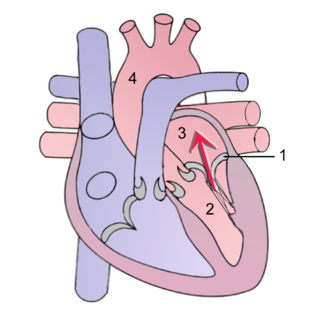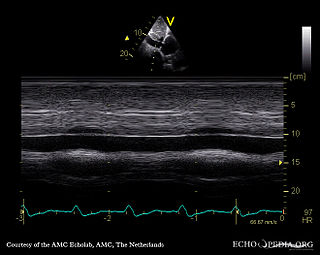Related Research Articles

Angiotensin-converting-enzyme inhibitors are a class of medication used primarily for the treatment of high blood pressure and heart failure. This class of medicine works by causing relaxation of blood vessels as well as a decrease in blood volume, which leads to lower blood pressure and decreased oxygen demand from the heart.

Heart failure (HF), also known as congestive heart failure (CHF), is a syndrome, a group of signs and symptoms, caused by an impairment of the heart's blood pumping function. Symptoms typically include shortness of breath, excessive fatigue, and leg swelling. The shortness of breath may occur with exertion or while lying down, and may wake people up during the night. Chest pain, including angina, is not usually caused by heart failure, but may occur if the heart failure was caused by a heart attack. The severity of the heart failure is mainly decided based on ejection fraction and also measured by the severity of symptoms. Other conditions that may have symptoms similar to heart failure include obesity, kidney failure, liver disease, anemia, and thyroid disease.

An implantable cardioverter-defibrillator (ICD) or automated implantable cardioverter defibrillator (AICD) is a device implantable inside the body, able to perform defibrillation, and depending on the type, cardioversion and pacing of the heart. The ICD is the first-line treatment and prophylactic therapy for patients at risk for sudden cardiac death due to ventricular fibrillation and ventricular tachycardia.
Antihypertensives are a class of drugs that are used to treat hypertension. Antihypertensive therapy seeks to prevent the complications of high blood pressure, such as stroke, heart failure, kidney failure and myocardial infarction. Evidence suggests that reduction of the blood pressure by 5 mmHg can decrease the risk of stroke by 34% and of ischaemic heart disease by 21%, and can reduce the likelihood of dementia, heart failure, and mortality from cardiovascular disease. There are many classes of antihypertensives, which lower blood pressure by different means. Among the most important and most widely used medications are thiazide diuretics, calcium channel blockers, ACE inhibitors, angiotensin II receptor antagonists (ARBs), and beta blockers.

Aortic regurgitation (AR), also known as aortic insufficiency (AI), is the leaking of the aortic valve of the heart that causes blood to flow in the reverse direction during ventricular diastole, from the aorta into the left ventricle. As a consequence, the cardiac muscle is forced to work harder than normal.

Indapamide is a thiazide-like diuretic drug used in the treatment of hypertension, as well as decompensated heart failure. Combination preparations with perindopril are available. The thiazide-like diuretics reduce risk of major cardiovascular events and heart failure in hypertensive patients compared with hydrochlorothiazide with a comparable incidence of adverse events. Both thiazide diuretics and thiazide-like diuretics are effective in reducing risk of stroke. Both drug classes appear to have comparable rates of adverse effects as other antihypertensives such as angiotensin II receptor blockers and dihydropyridine calcium channel blockers and lesser prevalence of side-effects when compared to ACE-inhibitors and non-dihydropyridine calcium channel blockers.

Mitral regurgitation(MR), also known as mitral insufficiency or mitral incompetence, is a form of valvular heart disease in which the mitral valve is insufficient and does not close properly when the heart pumps out blood. It is the abnormal leaking of blood backwards – regurgitation from the left ventricle, through the mitral valve, into the left atrium, when the left ventricle contracts. Mitral regurgitation is the most common form of valvular heart disease.
In cardiology, ventricular remodeling refers to changes in the size, shape, structure, and function of the heart. This can happen as a result of exercise or after injury to the heart muscle. The injury is typically due to acute myocardial infarction, but may be from a number of causes that result in increased pressure or volume, causing pressure overload or volume overload on the heart. Chronic hypertension, congenital heart disease with intracardiac shunting, and valvular heart disease may also lead to remodeling. After the insult occurs, a series of histopathological and structural changes occur in the left ventricular myocardium that lead to progressive decline in left ventricular performance. Ultimately, ventricular remodeling may result in diminished contractile (systolic) function and reduced stroke volume.
Hydralazine/isosorbide dinitrate, sold under the brand name Bidil, is a fixed-dose combination medication used to treat self-identified Black people with congestive heart failure. It is a combination of hydralazine hydrochloride and isosorbide dinitrate.

Perindopril is a medication used to treat high blood pressure, heart failure, or stable coronary artery disease.

Levosimendan (INN) is a calcium sensitizer used in the management of acutely decompensated congestive heart failure. It is marketed under the trade name Simdax. Overall the drug has a two fold mechanism of action. It leads to greater inotrophy by increasing the calcium sensitivity as it binds to troponin and this results in a greater positive inotrophic force. Secondly, the drug is able to open ATP sensitive potassium channels in vascular smooth muscle cells, and the vascular dilatory effects of the drug lead to a decreased preload and afterload, putting less work on the heart. This drug is in the process of review by the FDA but has not been approved for use in the United States yet.

Amrinone, also known as inamrinone, and sold as Inocor, is a pyridine phosphodiesterase 3 inhibitor. It is a drug that may improve the prognosis in patients with congestive heart failure. Amrinone has been shown to increase the contractions initiated in the heart by high-gain calcium induced calcium release (CICR). The positive inotropic effect of amrinone is mediated by the selective enhancement of high-gain CICR, which contributes to the contraction of myocytes by phosphorylation through cAMP dependent protein kinase A (PKA) and Ca2+ calmodulin kinase pathways.

Tricuspid regurgitation (TR), also called tricuspid insufficiency, is a type of valvular heart disease in which the tricuspid valve of the heart, located between the right atrium and right ventricle, does not close completely when the right ventricle contracts (systole). TR allows the blood to flow backwards from the right ventricle to the right atrium, which increases the volume and pressure of the blood both in the right atrium and the right ventricle, which may increase central venous volume and pressure if the backward flow is sufficiently severe.

Aquapheresis is a medical technology designed to remove excess salt and water from the body safely, predictably, and effectively from patients with a condition called fluid overload. It removes the excess salt and water and helps to restore a patient's proper fluid balance, which is called euvolemia.

Acute decompensated heart failure (ADHF) is a sudden worsening of the signs and symptoms of heart failure, which typically includes difficulty breathing (dyspnea), leg or feet swelling, and fatigue. ADHF is a common and potentially serious cause of acute respiratory distress. The condition is caused by severe congestion of multiple organs by fluid that is inadequately circulated by the failing heart. An attack of decompensation can be caused by underlying medical illness, such as myocardial infarction, an abnormal heart rhythm, infection, or thyroid disease.
Cardiorenal syndrome (CRS) is an umbrella term used in the medical field that defines disorders of the heart and kidneys whereby "acute or chronic dysfunction in one organ may induce acute or chronic dysfunction of the other". When one of these organs fails, the other may subsequently fail. The heart and the kidneys are involved in maintaining hemodynamic stability and organ perfusion through an intricate network. Patients who have renal failure first may be hard to determine if heart failure is concurrent. These two organs communicate with one another through a variety of pathways in an interdependent relationship. In a 2004 report from the National Heart, Lung and Blood Institute, CRS was defined as a condition where treatment of congestive heart failure is limited by decline in kidney function. This definition has since been challenged repeatedly but there still remains little consensus over a universally accepted definition for CRS. At a consensus conference of the Acute Dialysis Quality Initiative (ADQI), the CRS was classified into five subtypes primarily based upon the organ that initiated the insult as well as the acuity of disease.
A fluid restriction diet is a diet which limits the amount of daily fluid consumption. Besides beverages, many foods also include fluids which needs to be taken into consideration. A fluid-restrictive diet assists in preventing the build-up of fluids in the body. Reducing fluid intake can alleviate stress on the body and may reduce additional complications. A fluid restriction diet is generally medically advised for patients with "heart problems, renal disease, liver damage including cirrhosis, endocrine and adrenal gland issues, elevated stress hormones and hyponatremia". Patients with heart failure are recommended to restrict fluid intake down to 2 quarts per day.
Cardiac contractility modulation is a therapy which is intended for the treatment of patients with moderate to severe heart failure with symptoms despite optimal medical therapy who can benefit from an improvement in cardiac output. The short- and long-term use of this therapy enhances the strength of ventricular contraction and therefore the heart's pumping capacity by modulating (adjusting) the myocardial contractility. This is provided by a pacemaker-like device that applies non-excitatory electrical signals adjusted to and synchronized with the electrical action in the cardiac cycle.

Sacubitril/valsartan, sold under the brand name Entresto, is a fixed-dose combination medication for use in heart failure. It consists of the neprilysin inhibitor sacubitril and the angiotensin receptor blocker valsartan. The combination is sometimes described as an "angiotensin receptor-neprilysin inhibitor" (ARNi). In 2016, the American College of Cardiology/American Heart Association Task Force recommended it as a replacement for an ACE inhibitor or an angiotensin receptor blocker in people with heart failure with reduced ejection fraction.

Heart failure with preserved ejection fraction (HFpEF) is a form of heart failure in which the ejection fraction – the percentage of the volume of blood ejected from the left ventricle with each heartbeat divided by the volume of blood when the left ventricle is maximally filled – is normal, defined as greater than 50%; this may be measured by echocardiography or cardiac catheterization. Approximately half of people with heart failure have preserved ejection fraction, while the other half have a reduction in ejection fraction, called heart failure with reduced ejection fraction (HFrEF).
References
- 1 2 Smith A, Aylward P, Campbell T, et al. Therapeutic Guidelines: Cardiovascular, 4th edition. North Melbourne: Therapeutic Guidelines; 2003. ISSN 1327-9513
- ↑ Chaudhry SI, et al. (2007). "Patterns of Weight Change Preceding Hospitalization for Heart Failure". Circulation. 116 (14): 1549–54. doi:10.1161/CIRCULATIONAHA.107.690768. PMC 2892745 . PMID 17846286.
- 1 2 Tai MK (October 2009). "[Evidence-based practice of fluid restriction in patients with heart failure]". Hu Li Za Zhi (in Chinese). 56 (5): 23–29. PMID 19760574.
- ↑ Jackson S, Bereznicki L, Peterson G (2005). "Under-use of ACE-inhibitor and β-blocker therapies in congestive cardiac failure". Australian Pharmacist. 24 (12): 936.
- ↑ Packer M (1989). "Effect of phosphodiesterase inhibitors on survival of patients with chronic congestive heart failure". Am. J. Cardiol. 63 (2): 41A–45A. doi:10.1016/0002-9149(89)90392-5. PMID 2642629.
- ↑ Packer M, Carver JR, Rodeheffer RJ, et al. (1991). "Effect of oral milrinone on mortality in severe chronic heart failure. The PROMISE Study Research Group". N. Engl. J. Med. 325 (21): 1468–75. doi: 10.1056/NEJM199111213252103 . PMID 1944425.
- ↑ Hunt SA, Abraham WT, Chin MH, et al. (2005). "ACC/AHA 2005 Guideline Update for the Diagnosis and Management of Chronic Heart Failure in the Adult". Circulation. 112 (12): e154–235. doi: 10.1161/CIRCULATIONAHA.105.167586 . PMID 16160202.
- ↑ Krum H, National Heart Foundation of Australia and Cardiac Society of Australia & New Zealand Chronic Heart Failure Clinical Practice Guidelines Writing Panel. (2001). "Guidelines for management of patients with chronic heart failure in Australia". Med J Aust. 174 (9): 459–66. doi:10.5694/j.1326-5377.2001.tb143375.x. PMID 11386592. S2CID 44913094.
- 1 2 3 4 5 National Institute for Clinical Excellence. Chronic heart failure: management of chronic heart failure in adults in primary and secondary care. Clinical Guideline 5. London: National Institute for Clinical Excellence; 2003 Jul. Available from: www.nice.org.uk/pdf/CG5NICEguideline.pdf Archived 27 September 2007 at the Wayback Machine
- ↑ Granger CB, McMurray JJ, Yusuf S, Held P, Michelson EL, Olofsson B, Ostergren J, Pfeffer MA, Swedberg K; CHARM Investigators and Committees. (2003). "Effects of candesartan in patients with chronic heart failure and reduced left-ventricular systolic function intolerant to angiotensin-converting-enzyme inhibitors: the CHARM-Alternative trial". Lancet. 362 (9386): 772–76. doi:10.1016/S0140-6736(03)14284-5. PMID 13678870. S2CID 5650345.
{{cite journal}}: CS1 maint: multiple names: authors list (link) - ↑ Pfeffer MA, Swedberg K, Granger CB, Held P, McMurray JJ, Michelson EL, Olofsson B, Ostergren J, Yusuf S, Pocock S; CHARM Investigators and Committees. (2003). "Effects of candesartan on mortality and morbidity in patients with chronic heart failure: the CHARM-Overall programme". Lancet. 362 (9386): 759–66. doi:10.1016/S0140-6736(03)14282-1. PMID 13678868. S2CID 15011437.
{{cite journal}}: CS1 maint: multiple names: authors list (link) - ↑ McMurray JJ, Ostergren J, Swedberg K, Granger CB, Michelson EL, Olofssun B, Yusuf S, Pfeffer, MA; CHARM Investigators and Committees. (2003). "Effects of candesartan on mortality and morbidity in patients with chronic heart failure: the CHARM-Added trial". Lancet. 362 (9386): 767–71. doi:10.1016/S0140-6736(03)14283-3. PMID 13678869. S2CID 7383954.
{{cite journal}}: CS1 maint: multiple names: authors list (link) - ↑ Cohn JN, Tognoni G; Valsartan Heart Failure Trial Investigators. (2001). "A randomized trial of the angiotensin-recepto blocker valsartan in chronic heart failure". N Engl J Med. 345 (23): 1667–75. doi: 10.1056/NEJMoa010713 . PMID 11759645.
{{cite journal}}: CS1 maint: multiple names: authors list (link) - ↑ Heran BS, Musini VM, Bassett K, Taylor RS, Wright JM (2012). "Angiotensin receptor blockers for heart failure". Cochrane Database of Systematic Reviews. 4 (23): CD003040. doi:10.1002/14651858.CD003040.pub2. PMC 6823214 . PMID 22513909.
- ↑ RADO, JP; BLUMENFELD, G; HAMMER, S (November 1959). "The effect of prednisone and 6-methylprednisolone on mercurial diuresis in patients with refractory cardiac edema". The American Journal of the Medical Sciences. 238 (5): 542–51. doi:10.1097/00000441-195911000-00003. PMID 14435747. S2CID 38687480.
- ↑ RIEMER, AD (April 1958). "Application of the newer corticosteroids to augment diuresis in congestive heart failure". The American Journal of Cardiology. 1 (4): 488–96. doi:10.1016/0002-9149(58)90120-6. PMID 13520608.
- ↑ NEWMAN, DA (15 February 1959). "Reversal of intractable cardiac edema with prednisone". New York State Journal of Medicine. 59 (4): 625–33. PMID 13632954.
- ↑ Zhang, H; Liu, C; Ji, Z; Liu, G; Zhao, Q; Ao, YG; Wang, L; Deng, B; Zhen, Y; Tian, L; Ji, L; Liu, K (September 2008). "Prednisone adding to usual care treatment for refractory decompensated congestive heart failure". International Heart Journal. 49 (5): 587–95. doi: 10.1536/ihj.49.587 . PMID 18971570.
- ↑ Liu, C; Liu, G; Zhou, C; Ji, Z; Zhen, Y; Liu, K (September 2007). "Potent diuretic effects of prednisone in heart failure patients with refractory diuretic resistance". The Canadian Journal of Cardiology. 23 (11): 865–68. doi:10.1016/s0828-282x(07)70840-1. PMC 2651362 . PMID 17876376.
- ↑ Liu, C; Chen, H; Zhou, C; Ji, Z; Liu, G; Gao, Y; Tian, L; Yao, L; Zheng, Y; Zhao, Q; Liu, K (October 2006). "Potent potentiating diuretic effects of prednisone in congestive heart failure". Journal of Cardiovascular Pharmacology. 48 (4): 173–76. doi: 10.1097/01.fjc.0000245242.57088.5b . PMID 17086096. S2CID 45800521.
- ↑ Massari, F; Mastropasqua, F; Iacoviello, M; Nuzzolese, V; Torres, D; Parrinello, G (March 2012). "The glucocorticoid in acute decompensated heart failure: Dr Jekyll or Mr Hyde?". The American Journal of Emergency Medicine. 30 (3): 517.e5–10. doi:10.1016/j.ajem.2011.01.023. PMID 21406321.
- ↑ Liu, C; Chen, Y; Kang, Y; Ni, Z; Xiu, H; Guan, J; Liu, K (October 2011). "Glucocorticoids improve renal responsiveness to atrial natriuretic peptide by up-regulating natriuretic peptide receptor-A expression in the renal inner medullary collecting duct in decompensated heart failure". The Journal of Pharmacology and Experimental Therapeutics. 339 (1): 203–09. doi:10.1124/jpet.111.184796. PMID 21737535. S2CID 1892149.
- ↑ Haji SA, Movahed A (2000). "Update on digoxin therapy in congestive heart failure". American Family Physician. 62 (2): 409–16. PMID 10929703.
- ↑ Exner DV, Dries DL, Domanski MJ, Cohn JN (2001). "Lesser response to angiotensin-converting-enzyme inhibitor therapy in black as compared with white patients with left ventricular dysfunction". N Engl J Med. 344 (18): 1351–57. doi: 10.1056/NEJM200105033441802 . PMID 11333991.
- ↑ Taylor AL, Ziesche S, Yancy C, Carson P, D'Agostino R Jr, Ferdinand K, Taylor M, Adams K, Sabolinski M, Worcel M, Cohn JN; African-American Heart Failure Trial Investigators. (2004). "Combination of isosorbide dinitrate and hydralazine in blacks with heart failure". N Engl J Med. 351 (20): 2049–57. doi: 10.1056/NEJMoa042934 . PMID 15533851. S2CID 12012042.
{{cite journal}}: CS1 maint: multiple names: authors list (link) - ↑ Pitt B, Zannad F, Remme W, Cody R, Castaigne A, Perez A, Palensky J, Wittes J (1999). "The Effect of Spironolactone on Morbidity and Mortality in Patients with Severe Heart Failure". N Engl J Med. 341 (10): 709–17. doi: 10.1056/NEJM199909023411001 . PMID 10471456.
- ↑ Pitt B, Williams G, Remme W, Martinez F, Lopez-Sendon J, Zannad F, Neaton J, Roniker B, Hurley S, Burns D, Bittman R, Kleiman J (2001). "The EPHESUS trial: eplerenone in patients with heart failure due to systolic dysfunction complicating acute myocardial infarction. Eplerenone Post-AMI Heart Failure Efficacy and Survival Study". Cardiovasc Drugs Ther. 15 (1): 79–87. doi:10.1023/A:1011119003788. PMID 11504167. S2CID 26172590.
- ↑ Gheorghiade M, Konstam MA, Burnett JC Jr, Grinfeld L, Maggioni AP, Swedberg K, Udelson JE, Zannad F, Cook T, Ouyang J, Zimmer C, Orlandi C; Efficacy of Vasopressin Antagonism in Heart Failure Outcome Study With Tolvaptan (EVEREST) Investigators. (2007). "Short-term clinical effects of tolvaptan, an oral vasopressin antagonist, in patients hospitalized for heart failure: the EVEREST Clinical Status Trials". JAMA. 297 (12): 1332–43. doi: 10.1001/jama.297.12.1332 . PMID 17384438.
{{cite journal}}: CS1 maint: multiple names: authors list (link) - ↑ Konstam MA, Gheorghiade M, Burnett JC Jr, Grinfeld L, Maggioni AP, Swedberg K, Udelson JE, Zannad F, Cook T, Ouyang J, Zimmer C, Orlandi C; Efficacy of Vasopressin Antagonism in Heart Failure Outcome Study With Tolvaptan (EVEREST) Investigators. (2007). "Effects of oral tolvaptan in patients hospitalized for worsening heart failure: the EVEREST Outcome Trial". JAMA. 297 (12): 1319–31. doi: 10.1001/jama.297.12.1319 . PMID 17384437.
{{cite journal}}: CS1 maint: multiple names: authors list (link) - ↑ Bristow MR, Saxon LA, Boehmer J, Krueger S, Kass DA, De Marco T, Carson P, DiCarlo L, DeMets D, White BG, DeVries DW, Feldman AM; Comparison of Medical Therapy, Pacing, and Defibrillation in Heart Failure (COMPANION) Investigators. (2004). "Cardiac-resynchronization therapy with or without an implantable defibrillator in advanced chronic heart failure". N Engl J Med. 350 (21): 2140–50. doi: 10.1056/NEJMoa032423 . PMID 15152059.
{{cite journal}}: CS1 maint: multiple names: authors list (link) - ↑ Cleland JG, Daubert JC, Erdmann E, Freemantle N, Gras D, Kappenberger L, Tavazzi L; Cardiac Resynchronization-Heart Failure (CARE-HF) Study Investigators. (2005). "The effect of cardiac resynchronization on morbidity and mortality in heart failure" (PDF). N Engl J Med. 352 (15): 1539–49. doi:10.1056/NEJMoa050496. PMID 15753115. S2CID 13938919.
{{cite journal}}: CS1 maint: multiple names: authors list (link) - ↑ Ruschitzka, F; et al. (10 October 2013). "Cardiac-Resynchronization Therapy in Heart Failure with a Narrow QRS Complex" (PDF). N Engl J Med. 369 (15): 1395–405. doi:10.1056/NEJMoa1306687. PMID 23998714. S2CID 205095941.
- ↑ Tracy, CM; et al. (2 October 2012). "2012 ACCF/AHA/HRS focused update of the 2008 guidelines for device-based therapy of cardiac rhythm abnormalities: a report of the American College of Cardiology Foundation/American Heart Association Task Force on Practice Guidelines and the Heart Rhythm Society. [corrected]". Circulation. 126 (14): 1784–800. doi: 10.1161/CIR.0b013e3182618569 . PMID 22965336.
- ↑ Abraham, W.T.; S.A. Smith (February 2013). "Devices in the management of advanced, chronic heart failure". Nat Rev Cardiol. 10 (2): 98–110. doi:10.1038/nrcardio.2012.178. PMC 3753073 . PMID 23229137.
- ↑ Giallauria, F.; et al. (August 2014). "Effects of cardiac contractility modulation by non-excitatory electrical stimulation on exercise capacity and quality of life: an individual patient's data meta-analysis of randomized controlled trials". Int J Cardiol. 175 (2): 352–57. doi:10.1016/j.ijcard.2014.06.005. PMID 24975782.
- ↑ Borggrefe, M.; D. Burkhoff (July 2012). "Clinical effects of cardiac contractility modulation (CCM) as a treatment for chronic heart failure". Eur J Heart Fail. 14 (7): 703–12. doi: 10.1093/eurjhf/hfs078 . PMID 22696514.
- ↑ Kuck, K.-H.; et al. (January 2014). "New devices in heart failure: an European Heart Rhythm Association report: developed by the European Heart Rhythm Association; endorsed by the Heart Failure Association". Europace. 16 (1): 109–28. doi: 10.1093/europace/eut311 . PMID 24265466.
- ↑ Kuschyk, J.; et al. (January 2015). "Efficacy and survival in patients with cardiac contractility modulation: Long-term single center experience in 81 patients". Int J Cardiol. 183: 76–81. doi:10.1016/j.ijcard.2014.12.178. PMID 25662055.
- ↑ Kuschyk, J. (2014). "Der Besondere Stellenwert der Kardialen Kontraktilitätsmodulation in der Devicetherapie". Herzmedizin. Retrieved 6 June 2014.
- ↑ clinicaltrials.gov Announcement of a study that will further investigate safety and efficacy of CCM devices
- ↑ Bardy GH, Lee KL, Mark DB, Poole JE, Packer DL, Boineau R, Domanski M, Troutman C, Anderson J, Johnson G, McNulty SE, Clapp-Channing N, Davidson-Ray LD, Fraulo ES, Fishbein DP, Luceri RM, Ip JH; Sudden Cardiac Death in Heart Failure Trial (SCD-HeFT) Investigators. (2005). "Amiodarone or an implantable cardioverter-defibrillator for congestive heart failure". N Engl J Med. 352 (3): 225–37. doi: 10.1056/NEJMoa043399 . PMID 15659722.
{{cite journal}}: CS1 maint: multiple names: authors list (link) - ↑ Moss AJ, Zareba W, Hall WJ, et al. (March 2002). "Prophylactic implantation of a defibrillator in patients with myocardial infarction and reduced ejection fraction". N. Engl. J. Med. 346 (12): 877–83. doi: 10.1056/NEJMoa013474 . PMID 11907286.
- ↑ Mark DB, Anstrom KJ, Sun JL, Clapp-Channing NE, Tsiatis AA, Davidson-Ray L, Lee KL, Bardy GH; Sudden Cardiac Death in Heart Failure Trial Investigators (September 2008). "Quality of life with defibrillator therapy or amiodarone in heart failure". N. Engl. J. Med. 359 (10): 999–1008. doi:10.1056/NEJMoa0706719. PMC 2823628 . PMID 18768943.
{{cite journal}}: CS1 maint: multiple names: authors list (link) - ↑ Poole JE, Johnson GW, Hellkamp AS, Anderson J, Callans DJ, Raitt MH, Reddy RK, Marchlinski FE, Yee R, Guarnieri T, Talajic M, Wilber DJ, Fishbein DP, Packer DL, Mark DB, Lee KL, Bardy GH; Sudden Cardiac Death in Heart Failure Trial Investigators (September 2008). "Prognostic Importance of Defibrillator Shocks in Patients with Heart Failure". N. Engl. J. Med. 359 (10): 1009–17. doi:10.1056/NEJMoa071098. PMC 2922510 . PMID 18768944.
{{cite journal}}: CS1 maint: multiple names: authors list (link) - ↑ Sanders GD, Hlatky MA, Owens DK (October 2005). "Cost-effectiveness of implantable cardioverter-defibrillators". N. Engl. J. Med. 353 (14): 1471–80. doi: 10.1056/NEJMsa051989 . PMID 16207849.
- 1 2 Tønnessen T, Knudsen CW (August 2005). "Surgical left ventricular remodeling in heart failure". Eur. J. Heart Fail. 7 (5): 704–09. doi: 10.1016/j.ejheart.2005.07.005 . PMID 16087128.
- ↑ Cooley DA, Collins HA, Morris GC, Chapman DW (May 1958). "Ventricular aneurysm after myocardial infarction; surgical excision with use of temporary cardiopulmonary bypass". J Am Med Assoc. 167 (5): 557–60. doi:10.1001/jama.1958.02990220027008. PMID 13538738.
- ↑ Dor V (September 2001). "The endoventricular circular patch plasty ("Dor procedure") in ischemic akinetic dilated ventricles" (PDF). Heart Fail Rev. 6 (3): 187–93. doi:10.1023/A:1011477132227. PMID 11391036. S2CID 12777305.
- ↑ Lundblad R, Abdelnoor M, Svennevig JL (September 2004). "Surgery for left ventricular aneurysm: early and late survival after simple linear repair and endoventricular patch plasty". J. Thorac. Cardiovasc. Surg. 128 (3): 449–56. doi: 10.1016/j.jtcvs.2004.04.017 . PMID 15354107.
- ↑ Mickleborough LL, Carson S, Ivanov J (April 2001). "Repair of dyskinetic or akinetic left ventricular aneurysm: results obtained with a modified linear closure". J. Thorac. Cardiovasc. Surg. 121 (4): 675–82. doi: 10.1067/mtc.2001.112633 . PMID 11279407.
- ↑ Athanasuleas CL, Buckberg GD, Stanley AW, et al. (October 2004). "Surgical ventricular restoration in the treatment of congestive heart failure due to post-infarction ventricular dilation". J. Am. Coll. Cardiol. 44 (7): 1439–45. doi: 10.1016/j.jacc.2004.07.017 . PMID 15464325.
- ↑ Velazquez EJ, Lee KL, O'Connor CM, et al. (December 2007). "The rationale and design of the Surgical Treatment for Ischemic Heart Failure (STICH) trial". J. Thorac. Cardiovasc. Surg. 134 (6): 1540–47. doi:10.1016/j.jtcvs.2007.05.069. PMC 3638867 . PMID 18023680.
- ↑ "Pioneers of heart surgery". NOVA Online: Cut to the heart. Retrieved 7 November 2007.
- ↑ Franco-Cereceda A, McCarthy PM, Blackstone EH, et al. (May 2001). "Partial left ventriculectomy for dilated cardiomyopathy: is this an alternative to transplantation?". J. Thorac. Cardiovasc. Surg. 121 (5): 879–93. doi: 10.1067/mtc.2001.113598 . PMID 11326231.
- ↑ Oz MC, Konertz WF, Kleber FX, et al. (October 2003). "Global surgical experience with the Acorn cardiac support device". J. Thorac. Cardiovasc. Surg. 126 (4): 983–91. doi: 10.1016/S0022-5223(03)00049-7 . PMID 14566236.
- ↑ Schenk S, Reichenspurner H, Boehm DH, et al. (June 2002). "Myosplint implant and shape-change procedure: intra- and peri-operative safety and feasibility". J. Heart Lung Transplant. 21 (6): 680–86. doi:10.1016/S1053-2498(01)00773-2. PMID 12057702.